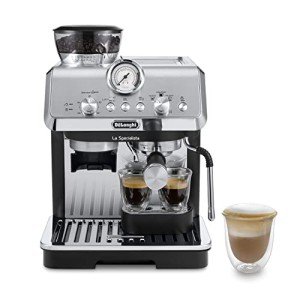Energy-Efficient Espresso Machines: A Comprehensive Guide
In the world of coffee enthusiasts, espresso machines are frequently related to as necessary appliances for brewing rich, aromatic coffee. Nevertheless, the energy usage associated with these machines can cause increased utility bills and ecological issues. As consumers end up being more eco-conscious, energy-efficient espresso machines have emerged as a popular option. This short article intends to check out the features, advantages, and options readily available in energy-efficient espresso machines, assisting coffee fans make informed options.
What Makes an Espresso Machine Energy-Efficient?
Energy-efficient espresso machines are designed to minimize energy usage while maintaining ideal efficiency. Several features add to the energy efficiency of these machines:
- Insulation: High-quality insulation helps maintain heat, minimizing the energy needed to keep optimum brewing temperature levels.
- Smart Technology: Many modern machines are geared up with programmable settings that allow users to arrange brewing times and switch to standby mode when not in use.
- Quick Heat-up Time: Energy-efficient espresso machines frequently use sophisticated heating innovations, such as thermoblocks or PID controllers, to heat water quickly.
- Low Wattage: Machines that run at lower wattages take in less energy overall, making them more efficient.
- Car Shut-off: Automatic shut-off features ensure that the machine switches off after a specific period of inactivity, further minimizing energy waste.
Benefits of Energy-Efficient Espresso Machines
Purchasing an energy-efficient espresso machine can provide a number of advantages:
- Cost Savings: Over time, lower energy consumption can lead to decreased electrical power bills.
- Ecological Impact: Using less energy lowers carbon footprints, making these machines a more sustainable choice for ecologically conscious consumers.
- Enhanced Performance: Many energy-efficient models also offer superior developing technologies, leading to better-tasting espresso.
- Sturdiness: Typically, energy-efficient machines are built with high-quality elements, resulting in greater longevity.
Features to Consider
When choosing an energy-efficient espresso machine, numerous features should be taken into consideration:
- Type of Machine: Options include manual, semi-automatic, and fully automatic models, each with differing degrees of user control and automation.
- Brew Quality: Look for machines that use high-quality developing systems to ensure optimum taste extraction.
- Upkeep: Some machines have self-cleaning functions that can conserve energy and effort in maintenance.
- Capacity: Depending on personal or household size, machine capability can affect energy intake, with larger machines frequently requiring more power.
Popular Energy-Efficient Espresso Machines
The market uses a range of energy-efficient espresso machines dealing with various needs and choices. Below are some noteworthy models:
| Brand | Design | Key Features | Energy Consumption |
|---|---|---|---|
| Breville | Barista Express | Integrated grinder, PID temperature level control, quick heat-up. | Low |
| DeLonghi | EC155 | Compact size, simple to use, long lasting develop. | Moderate |
| Rancilio | Silvia | Sturdy design, outstanding temperature level stability, and has a low environmental effect. | Moderate |
| Gaggia | Timeless | Dependable manual operation, durable brass components, and effective steaming ability. | Low |
| Jura | E8 | Completely automatic, smart features, and a removable brew group for easy cleaning. | Low |
Tips for Optimal Energy Efficiency
Aside from choosing an energy-efficient design, customers can embrace a number of practices to optimize energy efficiency:
- Preheat: If your machine has a pre-heating function, use it to guarantee that the optimum temperature level is reached rapidly before brewing.
- Turn Off After Use: Always turn off the machine after brewing or use machines with automobile shut-off features.
- Regular Maintenance: Keep the machine well-maintained to guarantee it runs effectively and efficiently.
FAQs About Energy-Efficient Espresso Machines
1. Are energy-efficient espresso machines more pricey?
While the initial investment may be greater for energy-efficient designs, the long-lasting savings on electrical energy expenses can offset the initial cost. In addition, numerous energy-efficient machines featured sophisticated features that boost the brewing experience.
2. How do I understand if an espresso machine is energy-efficient?
Search for signs such as Energy Star accreditation, user reviews, and specs concerning wattage and heat-up time. Machines with particular functions intended at decreasing energy consumption are normally developed for much better effectiveness.
3. Can I use an energy-efficient espresso machine for other coffee styles?
Many energy-efficient espresso machines use adaptability, permitting users to brew different coffee designs beyond espresso, such as lattes and cappuccinos, by including steaming capabilities.
4. Do energy-efficient designs sacrifice quality for performance?
Not always. sources tell me -efficient espresso machines are geared up with high-quality brewing innovation that can boost taste extraction while lowering energy intake.
5. What maintenance is needed for energy-efficient espresso machines?
Routine upkeep involves cleaning up the machine, descaling when necessary, and periodically checking seals and gaskets to guarantee optimal efficiency and energy effectiveness.
Energy-efficient espresso machines represent an ideal mix of performance, cost savings, and environmental responsibility. By considering various features, advantages, and brands, customers can pick a design that suits their distinct choices while contributing favorably to the environment. As the pattern towards sustainable living grows, the popularity of energy-efficient appliances, consisting of espresso machines, is likely to continue its upward trajectory, providing coffee fans a guilt-free way to enjoy their daily dose of espresso.

